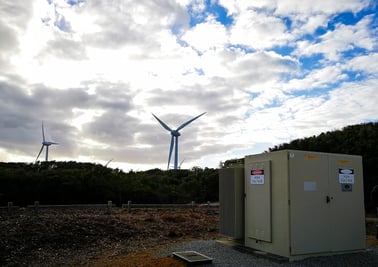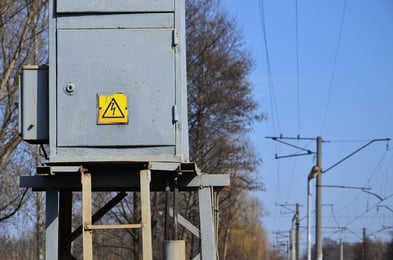What Is a Transformer Fire?
A transformer fire is a blaze that occurs within and around a transformer. A transformer is a piece of equipment that moves electric energy from one AC circuit to another (or multiple others) while changing its voltage. Transformers are an integral part of our infrastructure, and have been used since the 1890’s as part of our modern electrical grid.
The two main purposes that transformers are used for are to:
- Step down voltage from a standard power circuit in order to use it in lower voltage devices
- Step up voltage from a generator so it can travel long distances
Additionally, there are two factors that make transformer fires more likely to occur, and more dangerous when they do. The first factor is the high volume of electrical energy passing through a transformer, which generates a substantial amount of heat. The second is that many transformers utilize flammable mineral oil as an insulation and cooling fluid.
What Causes Transformers to Catch Fire?
Transformers, with their known fire risks, have been very carefully engineered and regulated to reduce the danger of fire as much as possible. But accidents, mechanical failure, and electrical overload do still cause a number of transformer fires each year. According to T&D World:
“The average probability of a serious transformer fire is on the order of 0.06% to 0.1% per service year, or one fire per 1,000 to 1,500 transformer service years. In practice, this means 2.4% to 4% of all transformers can be expected to cause a fire during a 40-year service life.”
The likelihood of and causes for a transformer fire varies considerably by the type and size of the transformer. Transformer age, design, operating environment, and maintenance history will also impact fire risk. 
In general, the most common transformer fire causes are:
- Lightning strikes or other extreme weather, like high winds or flooding that cause damage to the equipment or building, impacting indoor transformers.
- Mechanical failure can be caused by oil impregnated bushing failure, cable termination failure, tank ruptures, internal arcing, or conductor tipping. If you're wondering "what is an electric arc?" click here to find out.
- Electrical issues such as power surges, over-voltage, partial discharges, poor insulation, or static electrification also increase transformer fire risk.
What Causes Transformers to Explode?
Regardless of what causes transformers to spark and catch fire, there is an additional risk of transformer explosion during electrical fires. This is especially true of transformers that use mineral oil as an insulator and coolant. The mineral oil can quickly ignite and explode under certain conditions. This includes when a spark is present (as in a lighting strike or internal arcing) or when the mineral oil is overheated past the point of spontaneous combustion.
What Is the Advantage of a Dry-Type Transformer?
Alternatively, dry-type transformers are often used as a safer option for medium- and low-voltage needs (under 2.5-3 megavolt-amperes), especially for use indoors. Their biggest advantage is increased safety due to the lower fire and explosion risk. As their name implies, these transformers do not use oil to dissipate heat, but incorporate dry or gaseous mediums into the cooling coils instead.

There are three main varieties of dry-type transformers:
- Ventilated transformers utilize fan-assisted or natural circulation through openings in the transformer exterior.
- Encapsulated transformers have enclosed cooling coils inside solid materials–like epoxy, resin, sand, or gravel–that help with heat dissipation.
- Non-ventilated transformers dissipate heat through the surface area of the enclosure itself. These transformers are completely enclosed and especially used in areas that contain combustible, corrosive, or conductive materials that might cause damage.
Dry-type transformers have advantages outside of simply decreasing fire and explosion risk, such as:
- Eliminating the environmental risk of leaking or spilling oil
- Outperforming oil-filled transformers in some extreme environments
- Increased resistance to short circuits and power surges
- Decreased daily maintenance requirement due to no need to check for oil quality degradation or leakage
They do come with some disadvantages as well, however. These include:
- Less capacity for heat dissipation than oil transformers
- Shorter transformer life spans due to higher operating temperatures
- Decreased ability to recycle dry-type transformers at the end of their life
- Increased ambient temperatures around the transformers
How Do You Stop a Transformer Fire?
Under ideal circumstances, we would proactively stop transformer fires before they started. But despite best practices, fires do occasionally occur. When a fire does occur, fire suppression systems help to contain and suppress the fire as safely and efficiently as possible.
What Are the Six Components of a Fire Protection System?
- Fire alarm initiating devices - These activate fire suppression systems in case of fire. They include hardware like water flow switches in sprinklers and manual pull stations.
- Fire notification devices - These alert building occupants that there is a fire, and include fire alarms, horns, or strobing lights.
- Alarm monitoring systems - These automatically contact fire departments or other emergency responders in the event of a fire.
- Suppressant delivery systems - These deliver fire suppressants to the fire, and include hardware like sprinkler heads and piping.
- Primary and backup power supplies - These provide the power needed for active fire suppression systems. Backup power supplies enable functionality during power outages.
- Alarm control panels - These give emergency responders the ability to turn off fire notification systems after a fire has been put out.
How Do You Extinguish a Transformer Fire?
There are a variety of suppressant delivery systems that can be used to control or extinguish transformer fires. Water is the most common fire suppressing medium in general, but it is not always the most ideal for an electrical fire, especially in areas with other sensitive electrical equipment.
Types of water-based fire protection systems include:
- Deluge system - for transformer fire protection using high water volume. This system operates with open sprinkler heads attached to a dry water pipe system. When activated, the main water valve is open and water flows through the pipes and out all of the sprinkler heads at once.
- Fixed water spray system - for fire protection that is more targeted. This system utilizes a specific spray pattern designed for the footprint of the equipment being protected.
- Water mist system - for fire protection using less water. This system delivers small water droplets under high pressure which leads to larger heat absorption to cool a fire more quickly. The discontinuous nature of these water droplets also means this system offers good electrical insulation important in electrical firefighting efforts.
- Pre-action water mist system - for fire protection less prone to false initiation. This system requires two signals to activate, one from a detection system and one from direct heat activation at the sprinkler.
Types of non-water-based fire protection systems recommended for transformers:
- Indirect High Pressure (IHP) - equipped with its own automatic detection system, which when actuated, automatically releases the suppression agent (usually carbon dioxide) into the hazard area. IHP systems are typically used to protect transformers at wind turbine farms.
- Engineered Fire Suppression Systems - for use in total flooding applications to detect and suppress fire using clean agent. Engineered systems often suppress transformer fires in critical infrastructure applications.
What Are the NFPA Requirements for Transformers?
The National Fire Protection Association (NFPA) develops codes and standards for fire safety using experts with a wide range of professional expertise. Their requirements are used by many specific organizations and authorities having jurisdiction, so they are legally enforceable in many cases in the United States.
NFPA 850, Recommended Practice for Fire Protection for Electric Generating Plants and High Voltage Direct Current Converter Stations, specifically deals with transformer fire protection standards. It includes recommendations for transformers located both indoors and outdoors.
Indoor Guide for Transformer Fire Safety Practices
- Dry-type transformers should be used inside buildings whenever possible.
- If an oil-insulated transformer with over 100 gallons of oil is used inside, it must be separated by a fire wall with a three-hour fire resistance rating.
- If an automatic fire extinguishing system is in place, then the fire wall may be two-hour fire resistance rated.
Transformer Fire Protection System
It’s clear that having an effective, reliable system in place is needed to protect human life and any property that is nearby when a fire occurs. Two well-performing options include an indirect high-pressure and/or engineered system. The specific benefits these options can provide include:
- Rapid detection of fire directly at its source
- No human intervention needed with automatic suppression
- Clean agents are safe around other equipment, without residue or corrosive effects
- Installs quickly, so very little downtime in transformer usage
- Rated for harsh environments with no false alarms
- Stays active even during power outages since no power is required
- Suppressing agent qualifies as an Environment Friendly Clean Agent


